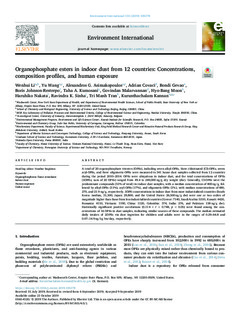Organophosphate esters in indoor dust from 12 countries: Concentrations, composition profiles, and human exposure
| dc.contributor.author | Li, Wenhui | |
| dc.contributor.author | Asimakopoulos, Alexandros | |
| dc.contributor.author | Covaci, Adrian | |
| dc.contributor.author | Gevao, Bondi | |
| dc.contributor.author | Johnson-Restrepo, Boris | |
| dc.contributor.author | Kumosani, Taha Abdullah | |
| dc.contributor.author | Malarvannan, Govindan | |
| dc.contributor.author | Moon, Hyo-Bang | |
| dc.contributor.author | Nakata, Haruhiko | |
| dc.contributor.author | Sinha, Ravindra K. | |
| dc.contributor.author | Tran, Tri Manh | |
| dc.contributor.author | Kannan, Kurunthachalam | |
| dc.date.accessioned | 2020-02-04T12:27:37Z | |
| dc.date.available | 2020-02-04T12:27:37Z | |
| dc.date.created | 2020-01-19T10:44:05Z | |
| dc.date.issued | 2019 | |
| dc.identifier.issn | 0160-4120 | |
| dc.identifier.uri | http://hdl.handle.net/11250/2639566 | |
| dc.description.abstract | A total of 20 organophosphate triesters (OPEs), including seven alkyl-OPEs, three chlorinated (Cl)-OPEs, seven aryl-OPEs, and three oligomeric-OPEs were measured in 341 house dust samples collected from 12 countries during the period 2010–2014. OPEs were ubiquitous in indoor dust, and the total concentrations of OPEs (∑OPEs; sum of 20 OPEs) ranged from 49.4 to 249,000 ng/g dry weight (dw). Generally, Cl-OPEs were the predominant compounds (51% of total) in indoor dust samples, with a median concentration of 800 ng/g, followed by alkyl-OPEs (31%), aryl-OPEs (17%), and oligomeric-OPEs (1%), with median concentrations of 480, 270, and 21.9 ng/g, respectively. ∑OPE concentrations in indoor dust from more industrialized countries (South Korea: median, 31,300; Japan: 29,800; and the United States: 26,500 ng/g dw) were one or two orders of magnitude higher than those from less industrialized countries (Greece: 7140, Saudi Arabia: 5310, Kuwait: 4420, Romania: 4110, Vietnam: 1190, China: 1120, Colombia: 374, India: 276, and Pakistan: 138 ng/g dw). Statistically significant positive correlations (0.114 < r < 0.748, p < 0.05) were found among the concentrations of 16 OPEs in dust samples, indicating similar sources of these compounds. The median estimated daily intakes of ΣOPEs via dust ingestion for children and adults were in the ranges of 0.29–64.8 and 0.07–14.9 ng/kg bw/day, respectively. | nb_NO |
| dc.language.iso | eng | nb_NO |
| dc.publisher | Elsevier | nb_NO |
| dc.rights | Attribution-NonCommercial-NoDerivatives 4.0 Internasjonal | * |
| dc.rights.uri | http://creativecommons.org/licenses/by-nc-nd/4.0/deed.no | * |
| dc.title | Organophosphate esters in indoor dust from 12 countries: Concentrations, composition profiles, and human exposure | nb_NO |
| dc.type | Journal article | nb_NO |
| dc.type | Peer reviewed | nb_NO |
| dc.description.version | publishedVersion | nb_NO |
| dc.source.volume | 133 | nb_NO |
| dc.source.journal | Environment International | nb_NO |
| dc.source.issue | 105178 | nb_NO |
| dc.identifier.doi | 10.1016/j.envint.2019.105178 | |
| dc.identifier.cristin | 1776661 | |
| dc.description.localcode | © 2019 The Authors. Published by Elsevier Ltd. This is an open access article under the CC BY-NC-ND license (http://creativecommons.org/licenses/BY-NC-ND/4.0/). | nb_NO |
| cristin.unitcode | 194,66,25,0 | |
| cristin.unitname | Institutt for kjemi | |
| cristin.ispublished | true | |
| cristin.fulltext | preprint | |
| cristin.qualitycode | 1 |
Tilhørende fil(er)
Denne innførselen finnes i følgende samling(er)
-
Institutt for kjemi [1390]
-
Publikasjoner fra CRIStin - NTNU [37995]

